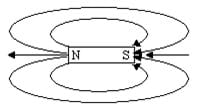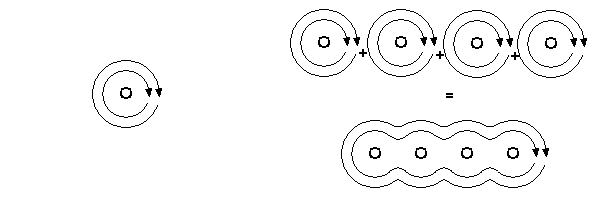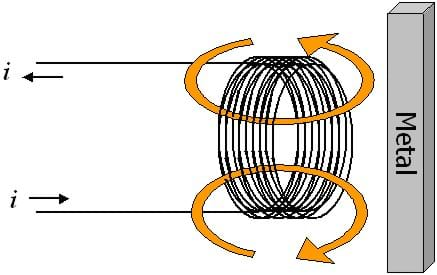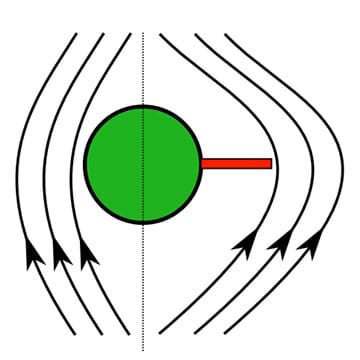Quick Look
Grade Level: 9 (8-10)
Time Required: 15 minutes
Lesson Dependency:
Subject Areas: Science and Technology
NGSS Performance Expectations:

| HS-PS3-5 |

Summary
Students complete the grand challenge of this unit and design an electromagnet to separate steel from aluminum for a recycler. In order to do this, they compare the induced magnetic field of an electric current with the magnetic field of a permanent magnet and then make the former look like the latter. They discover that looping the current produces the desired effect and find ways to further strengthen the magnetic field.Engineering Connection
The initial investigation into the correct shaping of the wire to achieve the desired field shape begins the engineering design process. During the activity, students proceed with the design process, making revisions to try to achieve the strongest electromagnet possible so as to pick up the most steel. Electromagnets are important inclusions to many electrical engineering designs and also supplement the work in other engineering disciplines such as mechanical and aerospace.
Learning Objectives
After this lesson, students should be able to:
- Describe how the magnetic field of an electric current can be used to create a magnetic field similar to that of a permanent magnet.
- Build an electromagnet.
- Identify the properties of an electromagnet that affect its strength.
Educational Standards
Each TeachEngineering lesson or activity is correlated to one or more K-12 science,
technology, engineering or math (STEM) educational standards.
All 100,000+ K-12 STEM standards covered in TeachEngineering are collected, maintained and packaged by the Achievement Standards Network (ASN),
a project of D2L (www.achievementstandards.org).
In the ASN, standards are hierarchically structured: first by source; e.g., by state; within source by type; e.g., science or mathematics;
within type by subtype, then by grade, etc.
Each TeachEngineering lesson or activity is correlated to one or more K-12 science, technology, engineering or math (STEM) educational standards.
All 100,000+ K-12 STEM standards covered in TeachEngineering are collected, maintained and packaged by the Achievement Standards Network (ASN), a project of D2L (www.achievementstandards.org).
In the ASN, standards are hierarchically structured: first by source; e.g., by state; within source by type; e.g., science or mathematics; within type by subtype, then by grade, etc.
NGSS: Next Generation Science Standards - Science
| NGSS Performance Expectation | ||
|---|---|---|
|
HS-PS3-5. Develop and use a model of two objects interacting through electric or magnetic fields to illustrate the forces between objects and the changes in energy of the objects due to the interaction. (Grades 9 - 12) Do you agree with this alignment? |
||
| Click to view other curriculum aligned to this Performance Expectation | ||
| This lesson focuses on the following Three Dimensional Learning aspects of NGSS: | ||
| Science & Engineering Practices | Disciplinary Core Ideas | Crosscutting Concepts |
| Develop and use a model based on evidence to illustrate the relationships between systems or between components of a system. Alignment agreement: | When two objects interacting through a field change relative position, the energy stored in the field is changed. Alignment agreement: | Cause and effect relationships can be suggested and predicted for complex natural and human designed systems by examining what is known about smaller scale mechanisms within the system. Alignment agreement: |
International Technology and Engineering Educators Association - Technology
-
Conduct research to inform intentional inventions and innovations that address specific needs and wants.
(Grades
9 -
12)
More Details
Do you agree with this alignment?
State Standards
Tennessee - Science
-
Understand magnetic poles, magnetic fields, and investigate electromagnetic induction.
(Grades
9 -
12)
More Details
Do you agree with this alignment?
-
Probe the fundamental principles and applications of electricity.
(Grades
9 -
12)
More Details
Do you agree with this alignment?
-
Create a simple electromagnet.
(Grades
9 -
12)
More Details
Do you agree with this alignment?
-
Create a simple electromagnet.
(Grades
9 -
12)
More Details
Do you agree with this alignment?
Worksheets and Attachments
Visit [www.teachengineering.org/lessons/view/van_cleanupmess_less4] to print or download.Pre-Req Knowledge
An understanding of the magnetic field produced by an electric current and the general properties of an electric current.
Introduction/Motivation
As you discovered in the activities with permanent magnets, in order to pick up only steel, you need a magnetic field shaped like this (draw the magnetic field lines of a permanent magnet or show the image), but in order to put the steel back down, you need a magnetic field you can turn off, which is an induced magnetic field and looks like this (draw the magnetic field lines of an induced magnetic field or show the image). As an engineer, how can you make this (indicate the induced magnetic field) look like this (indicate the permanent magnetic field)? (Ask the students to think about possible solutions and discuss their ideas. Do not completely give away the solution, but provide the second paragraph as guidance if no workable solutions are provided.)
To help you narrow down a solution, consider what happens when you have multiple magnetic fields. If the loops curl in the same direction, then the fields help each other and become stronger. If the fields curl in opposite directions, then the fields cancel each other. If you line up four wires so that all the currents go into the board, then the magnetic fields all curl the same way and you get this total magnetic field (draw the net magnetic field from superimposing the individual fields). This total field, especially if the wires are put close enough together, just looks like one big loop around all the wires. That's half of the loops you need to get the same effect as a permanent magnet.
(Begin the Building an Electromagnet associated activity.)
Lesson Background and Concepts for Teachers
Legacy Cycle Information
This lesson concludes the legacy cycle with the last iteration of Research and Revise, the summative quiz in Test Your Mettle, and the final share out of designs in Go Public. Students understand the fundamentals of magnetic fields and have a design of their own that will achieve the desired goal; they conclude by sharing their designs with other students.

Lecture Information
An electromagnet takes advantage of the induced magnetic field of an electric current to mimic a permanent magnet with the advantage that it can be shut off. An electromagnet requires a continuous supply of electrical energy in order to maintain a magnetic field, which differs from a permanent magnet that doesn't require power. In an electromagnet, the battery's chemical energy transforms to electrical energy in the wire. Additionally, electromagnetic energy in the nail transforms to heat energy. Because the magnetic fields obey the principle of superposition, lining up several wires with the currents all pointing in the same direction results in the net magnetic field of the four wires acting together being a larger loop around all the wires, as illustrated in Figure 3. In order to have the same shape and direction of loops as in a permanent magnet (see Figure 1), one needs a collection of wires with currents all going one way near a collection of wires with currents all pointing in the opposite direction of the first group. This can be achieved by looping the wire, with the overall effect illustrated in Figure 4.

The strength of this induced magnetic field, or electromagnet, is dependent on several factors. First, any induced magnetic field is proportional to the strength of the current inducing it. If the current in the electromagnet is increased, then the strength of its magnetic field increases. Next, the number of loops forming the electromagnet affects its strength as a magnet because the overlying fields support each other. If there are more loops and they are wound tightly together, the magnet is stronger. Finally, if the loops are formed around a material that is itself magnetic, the magnetic field induced by the current in turn induces a magnetic field in the material, further accentuating the overall strength of the electromagnet. If the core is made of iron, nickel, or cobalt, the electromagnet is strengthened.

Associated Activities
- Building an Electromagnet - Students use the knowledge gained in the first three activities of the unit about electromagnetism to meet the unit's grand challenge by designing an electromagnet to separate metal for recycling.
Assessment
Unit Quiz: For unit summative assessment, administer the 10-question Clean Up This Mess Quiz to assess students' understandings of permanent magnetic fields, induced magnetic fields and electromagnets. Administer the quiz after the construction of the electromagnet in Building an Electromagnet or after the presentations in Building an Electromagnet. Review students' answers to gauge their depth of comprehension.
Subscribe
Get the inside scoop on all things TeachEngineering such as new site features, curriculum updates, video releases, and more by signing up for our newsletter!More Curriculum Like This

Students induce EMF in a coil of wire using magnetic fields. Students review the cross product with respect to magnetic force and introduce magnetic flux, Faraday's law of Induction, Lenz's law, eddy currents, motional EMF and Induced EMF.

Students learn about nondestructive testing, the use of the finite element method (systems of equations) and real-world impacts, and then conduct mini-activities to apply Maxwell’s equations, generate currents, create magnetic fields and solve a system of equations. They see the value of NDE and FEM...

Students are introduced to the effects of magnetic fields in matter addressing permanent magnets, diamagnetism, paramagnetism, ferromagnetism and magnetization.

After a demonstration of the deflection of an electron beam, students review their knowledge of the cross-product and the right-hand rule with example problems. Students apply these concepts to understand the magnetic force on a current carrying wire. Through the associated activity, students furthe...
Copyright
© 2013 by Regents of the University of Colorado; original © 2011 Vanderbilt UniversityContributors
Justin Montenegro , Glencliff High School, Nashville TNSupporting Program
VU Bioengineering RET Program, School of Engineering, Vanderbilt UniversityAcknowledgements
The contents of this digital library curriculum were developed under National Science Foundation RET grant nos. 0338092 and 0742871. However, these contents do not necessarily represent the policies of the NSF, and you should not assume endorsement by the federal government.
Last modified: September 5, 2017









User Comments & Tips